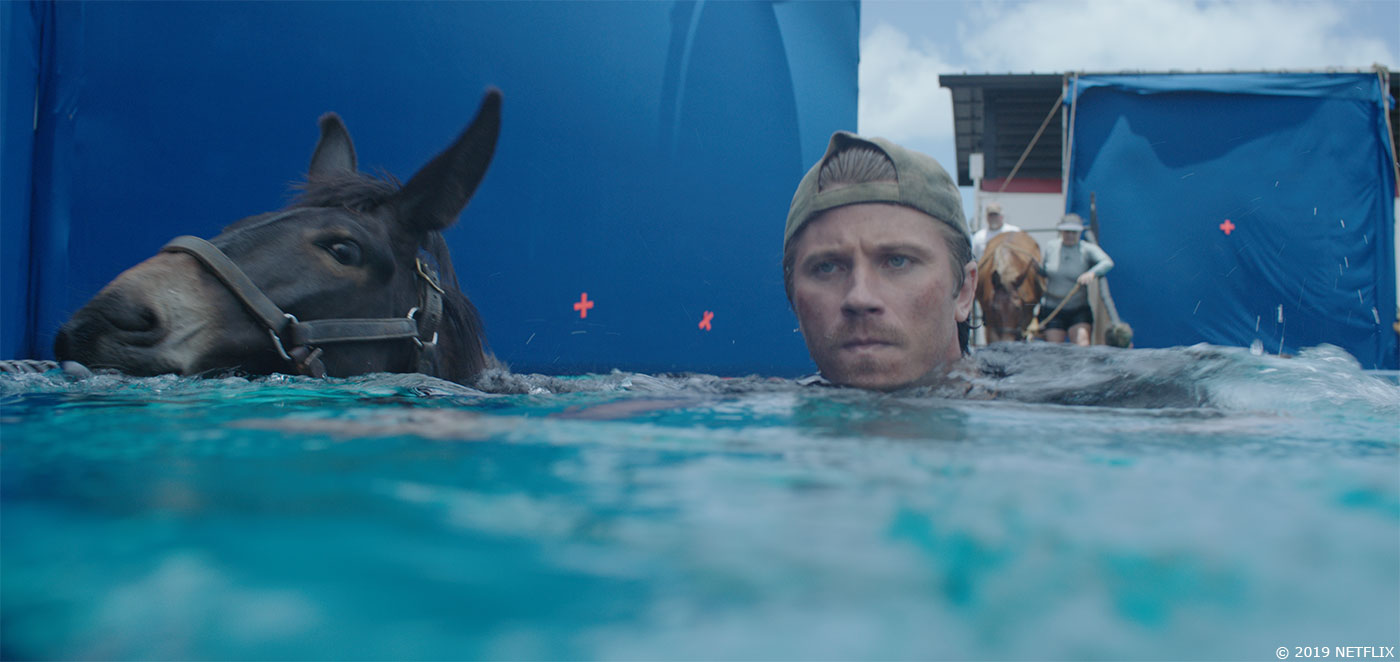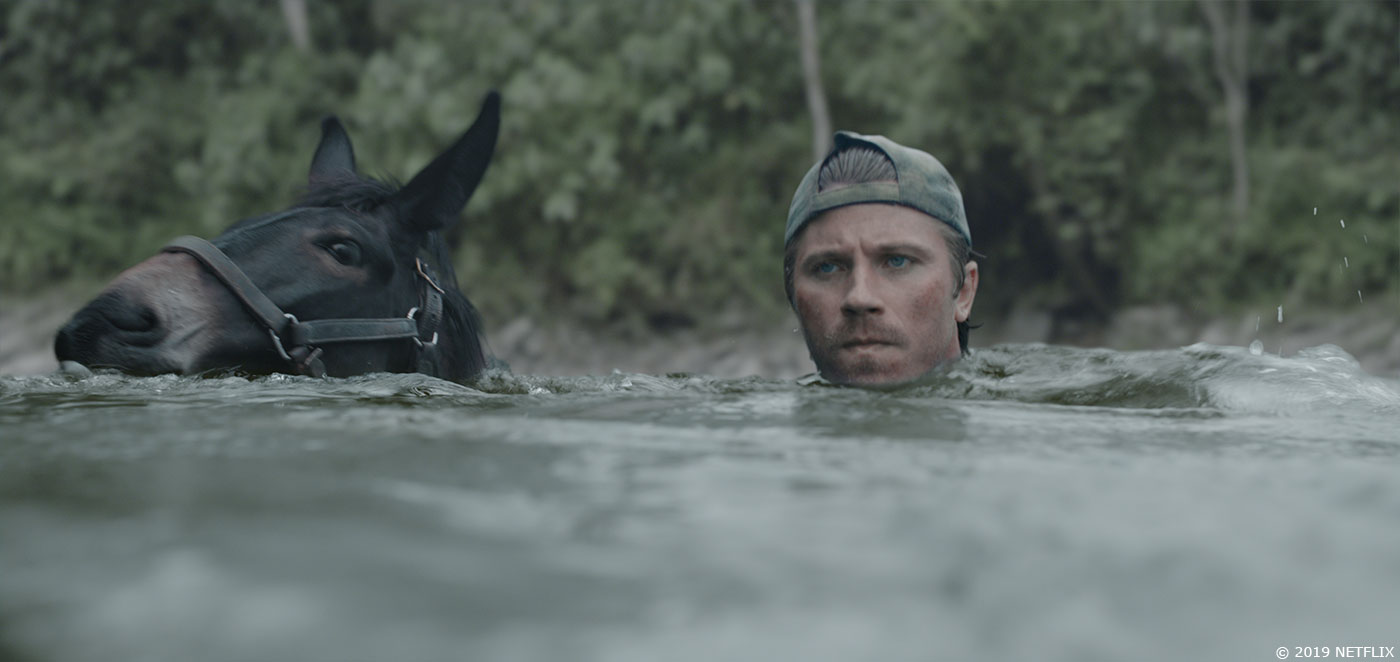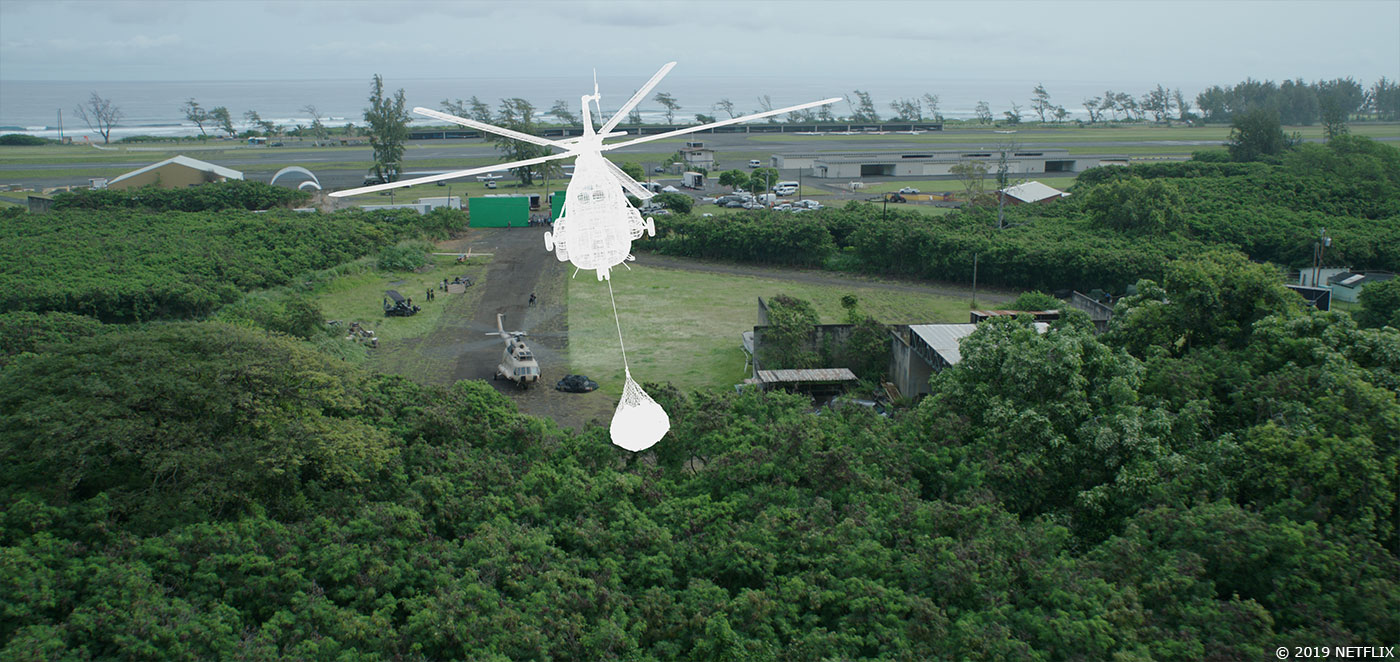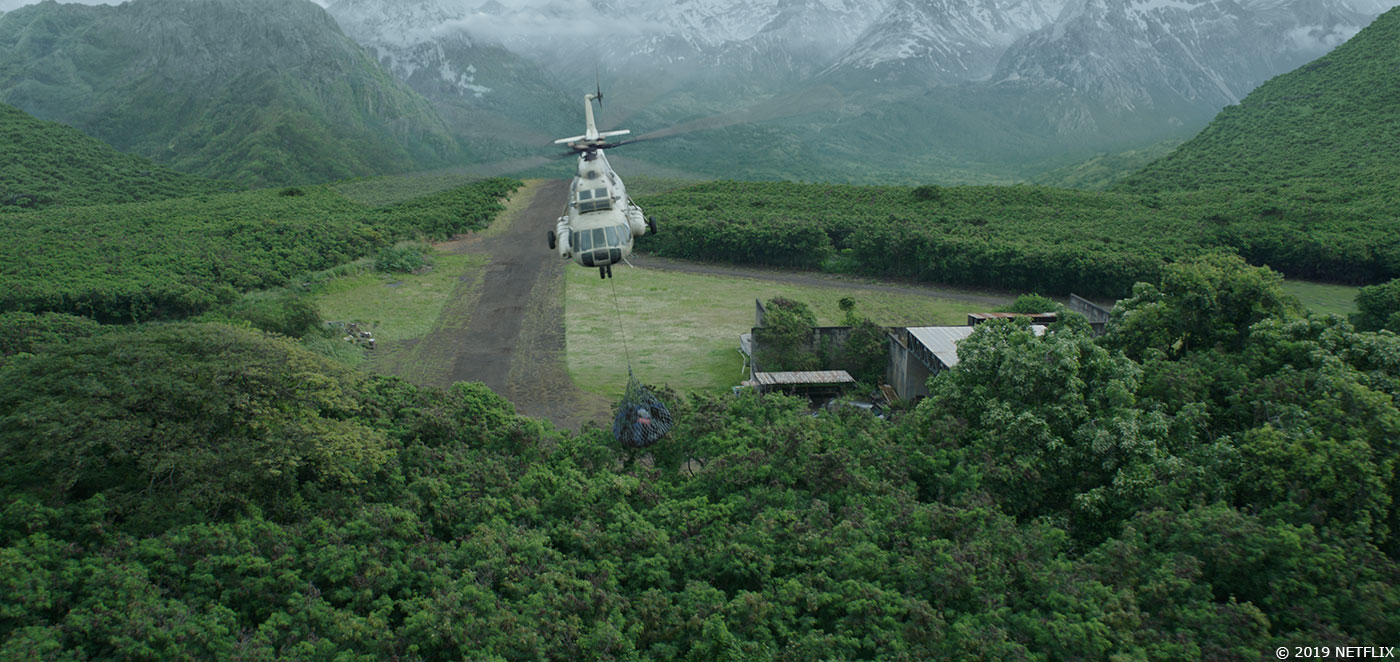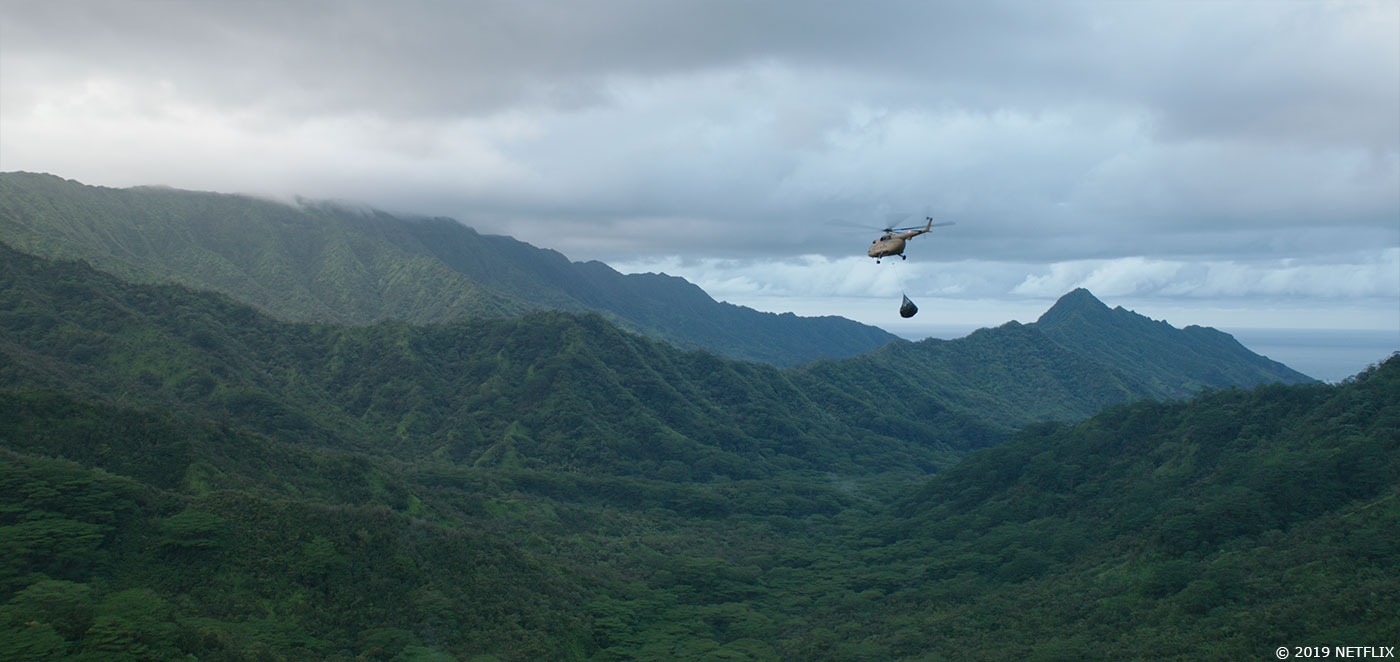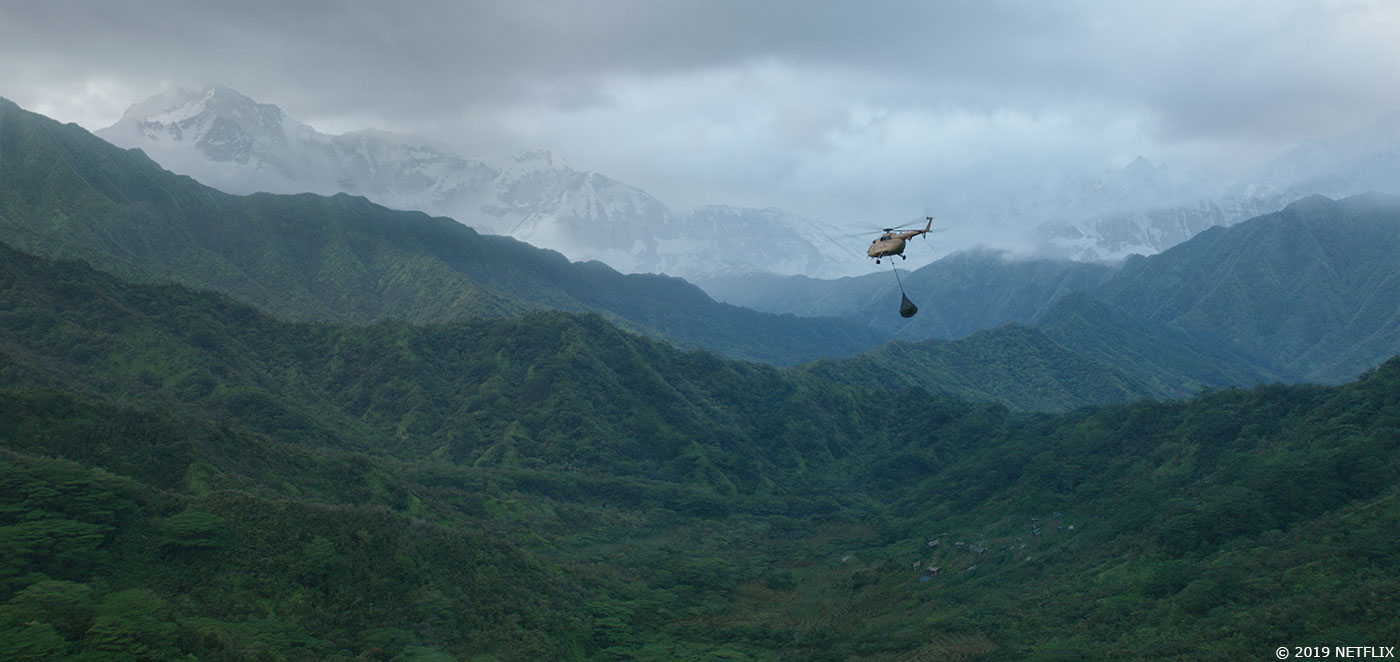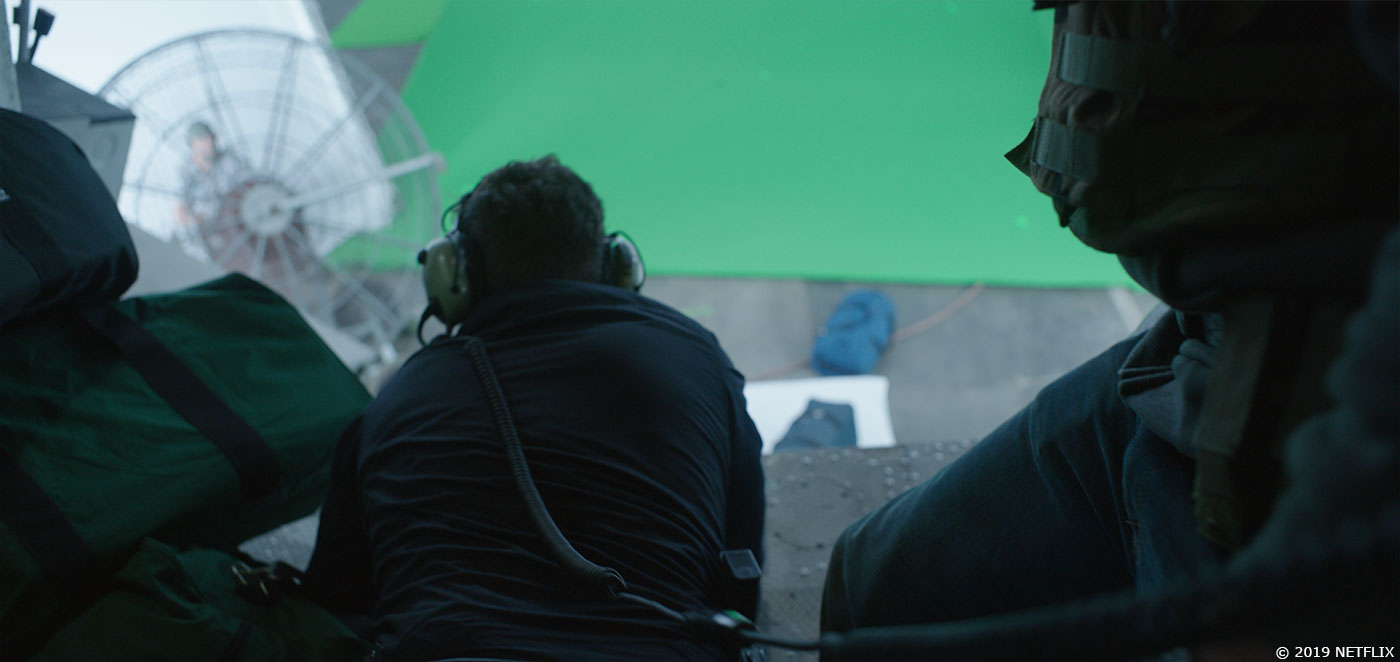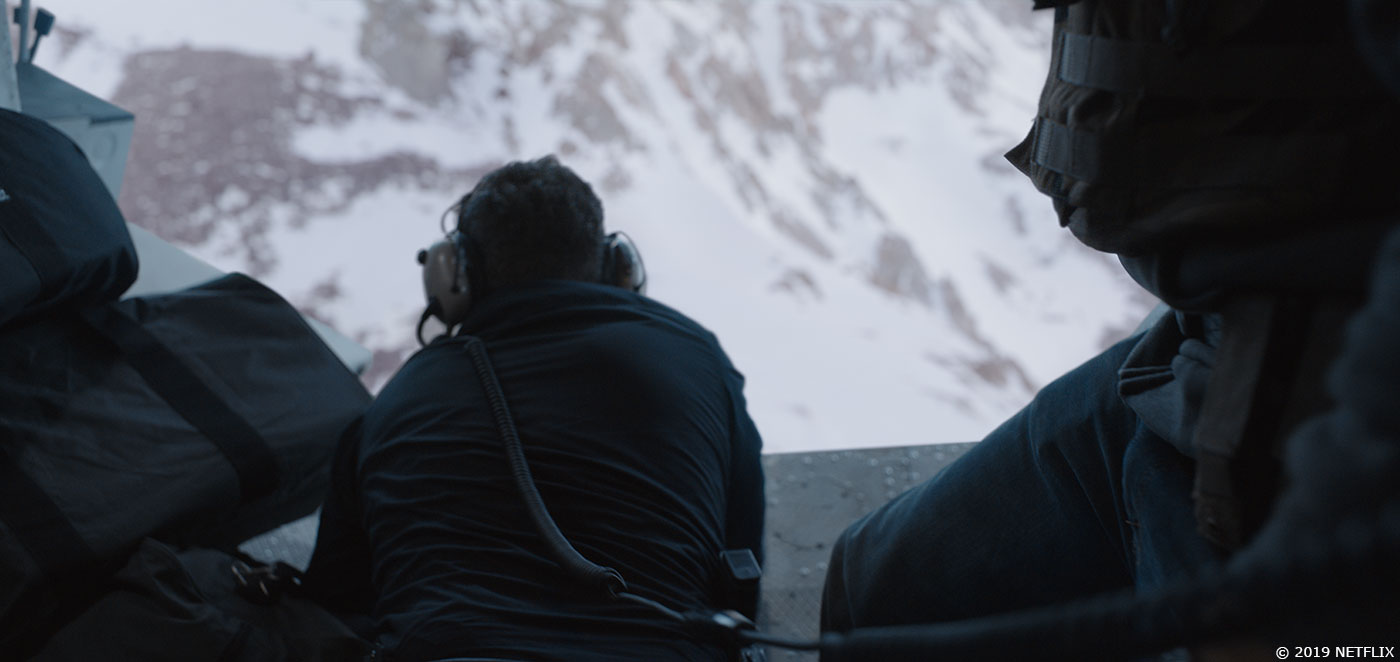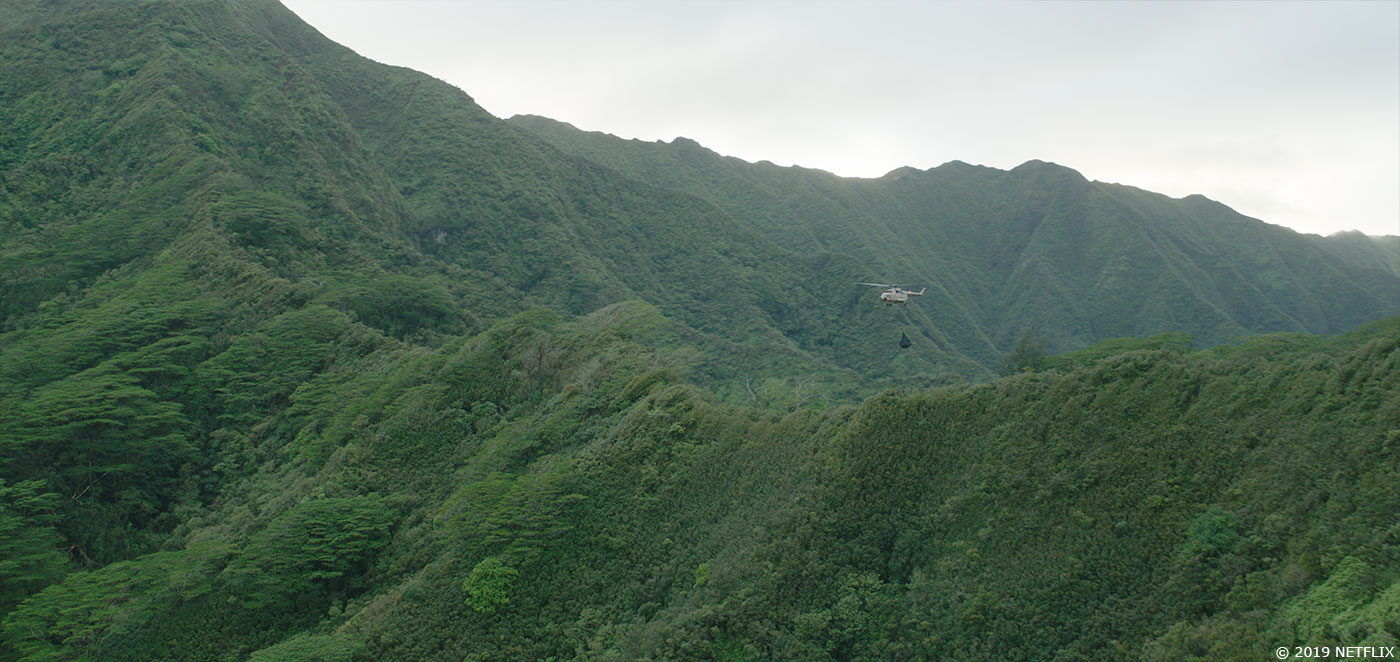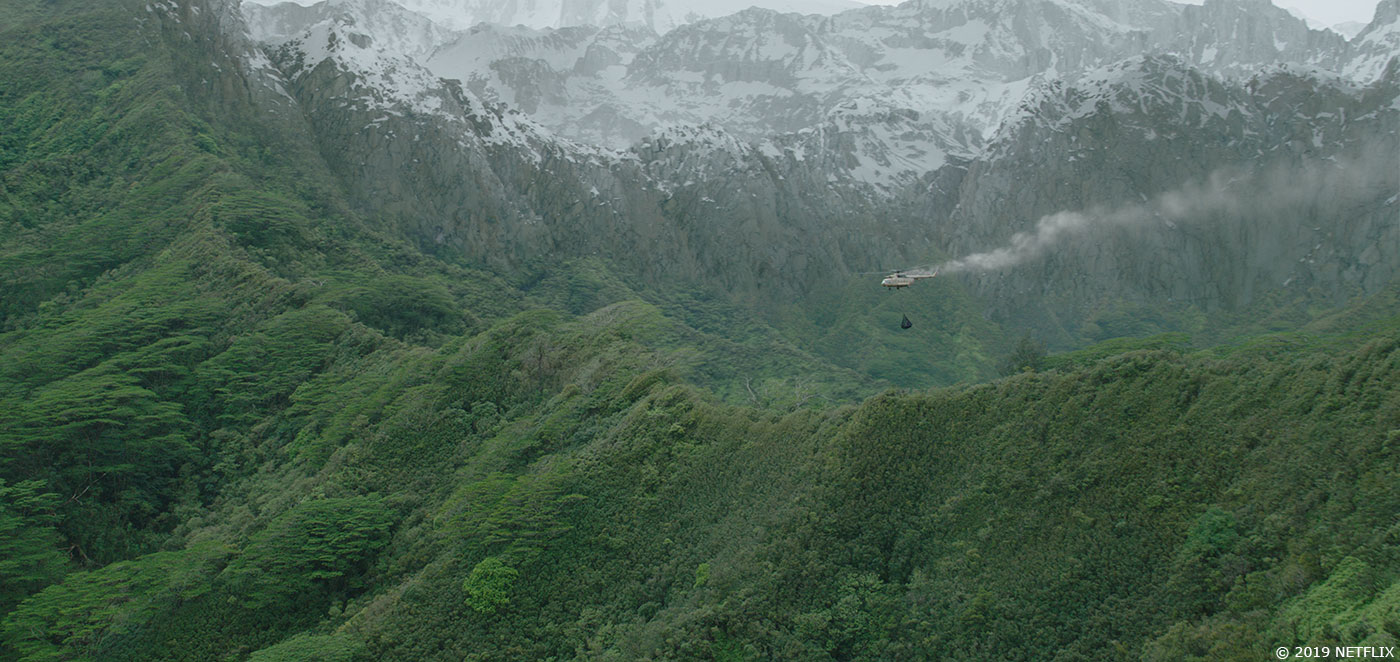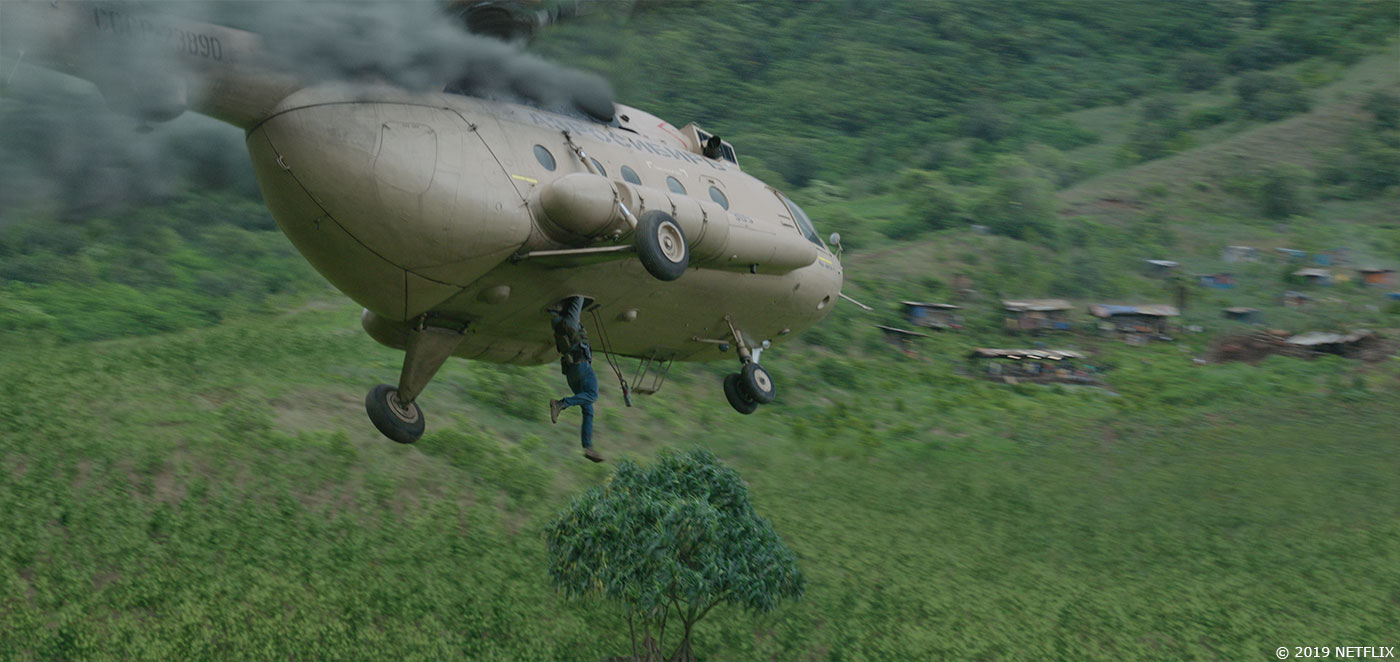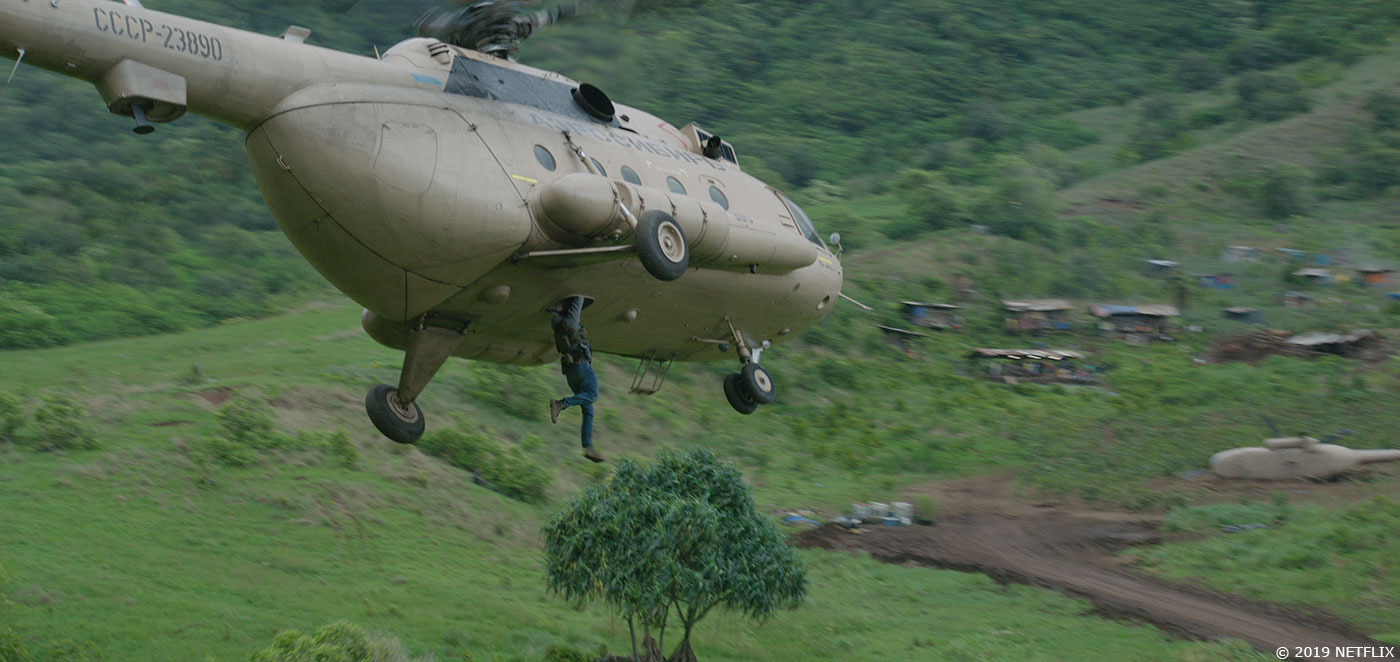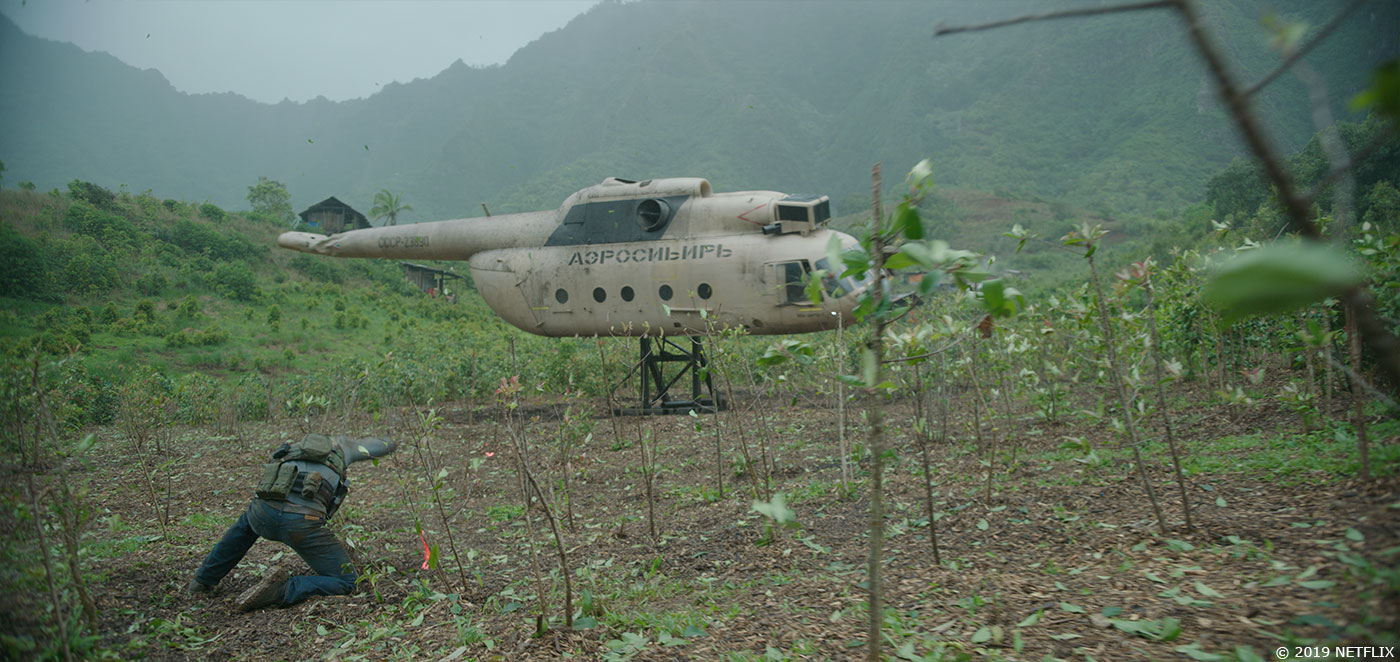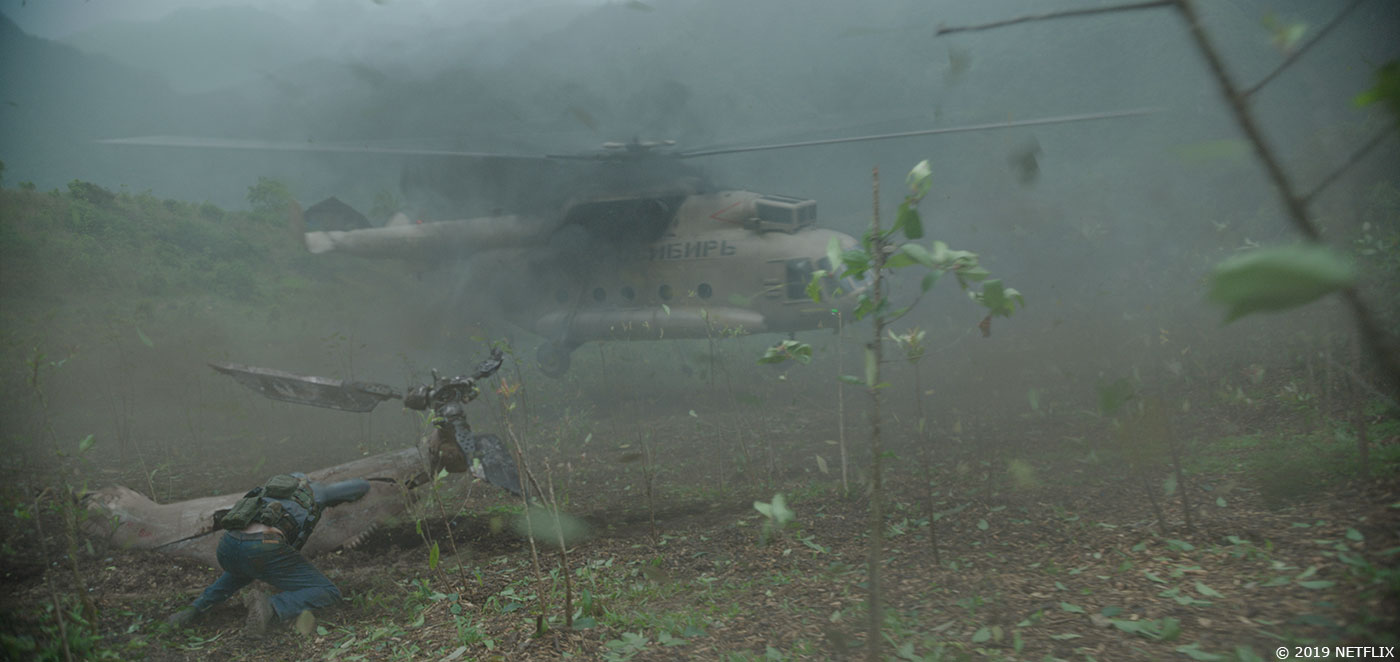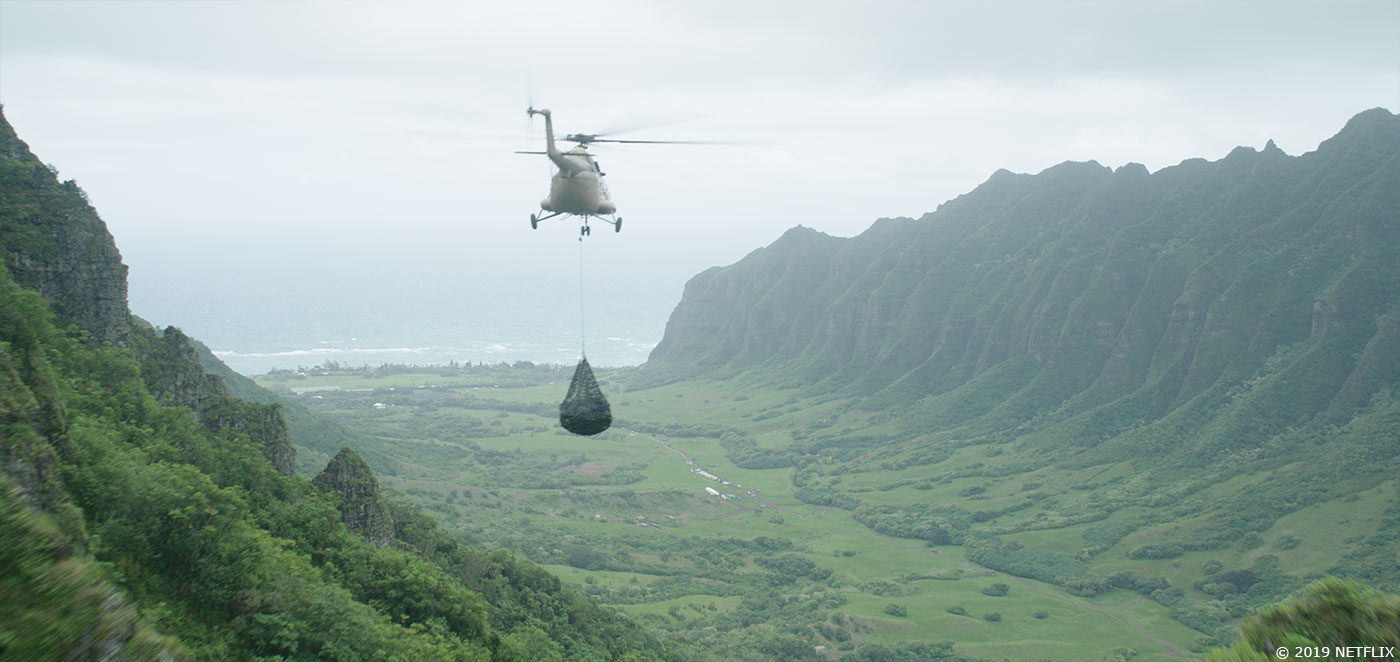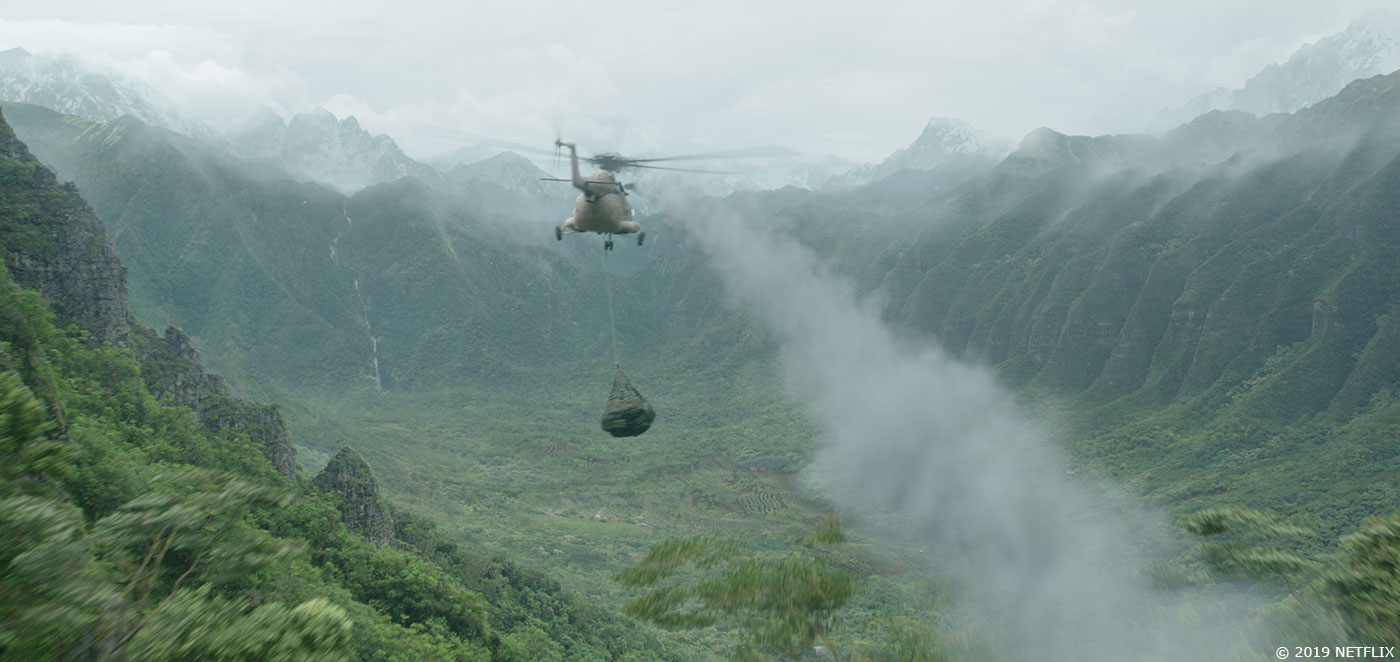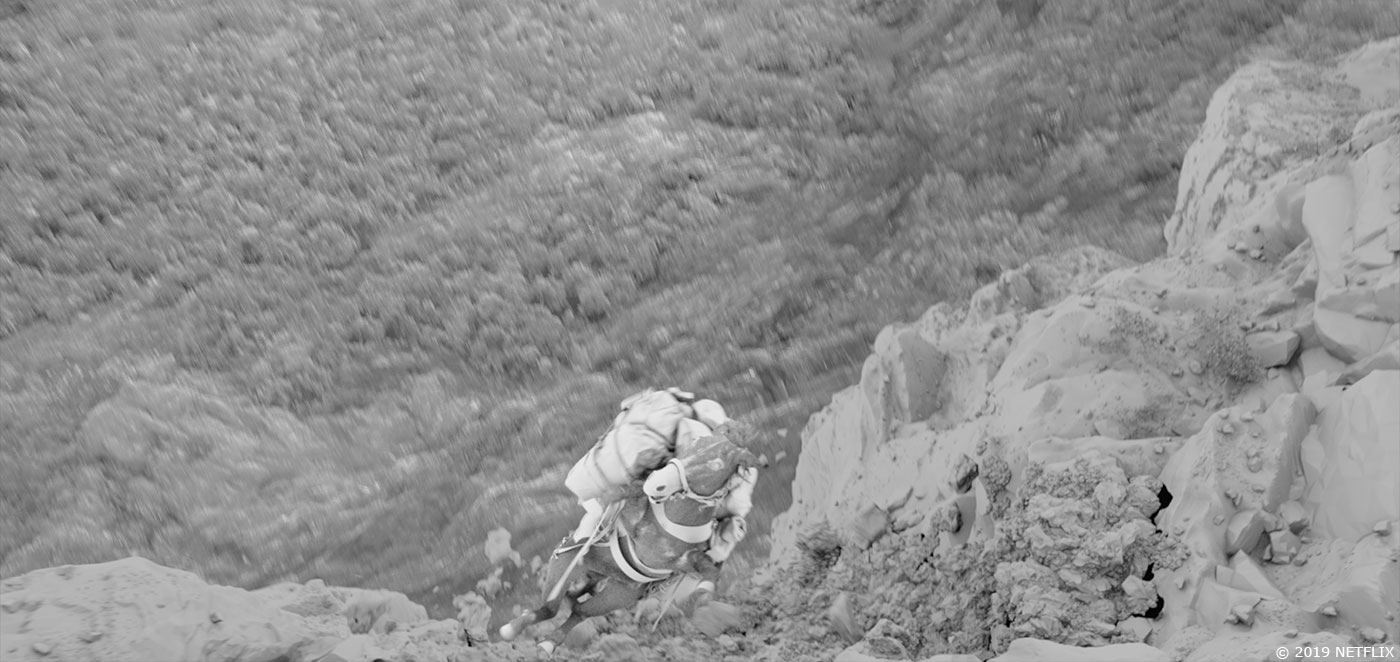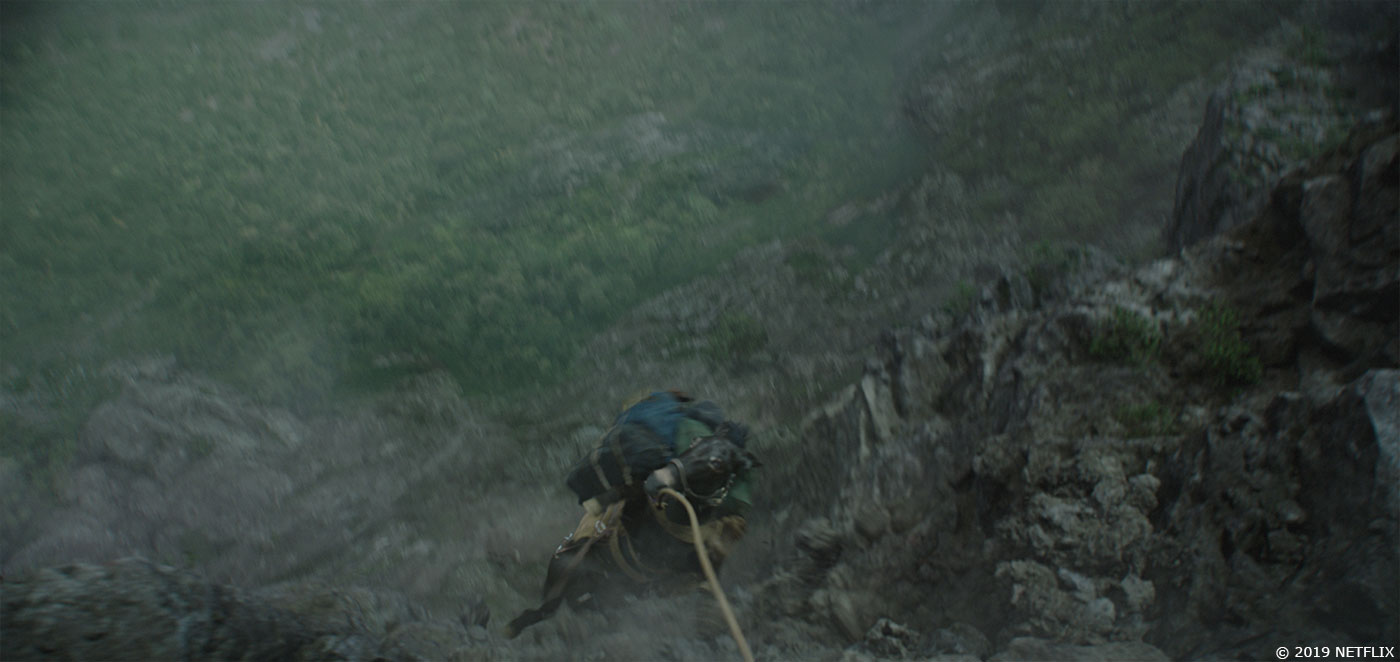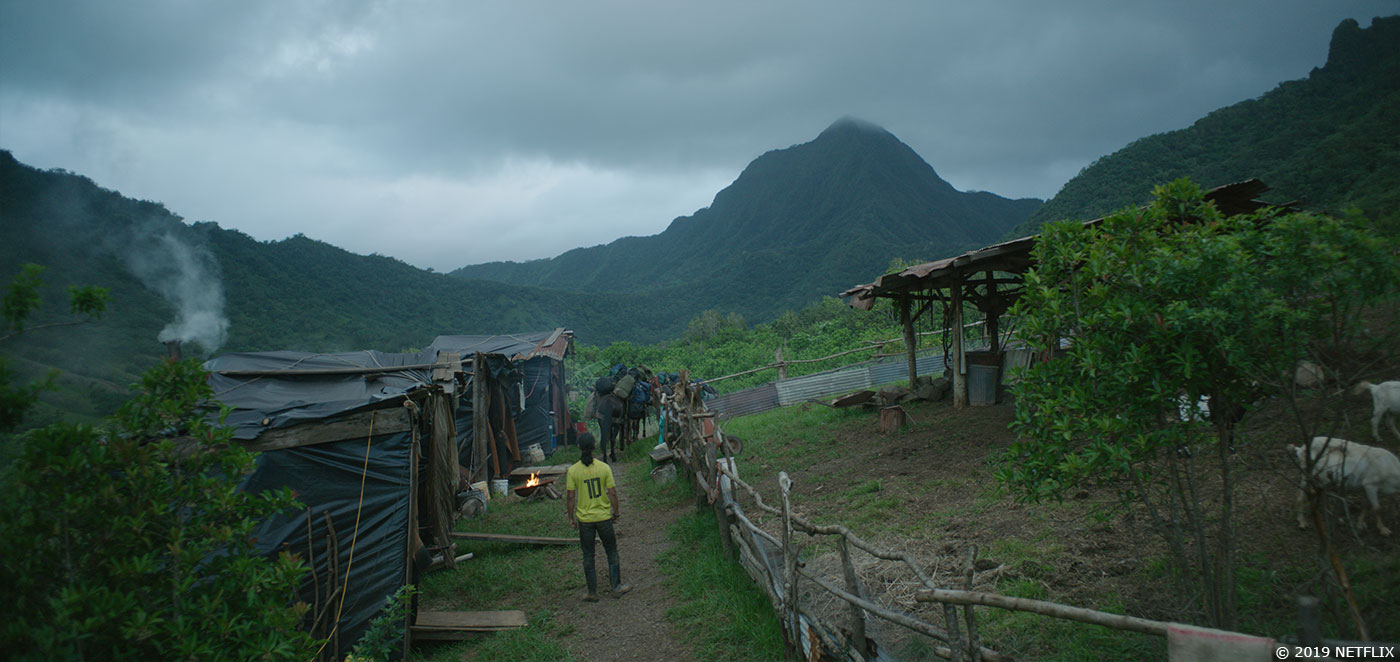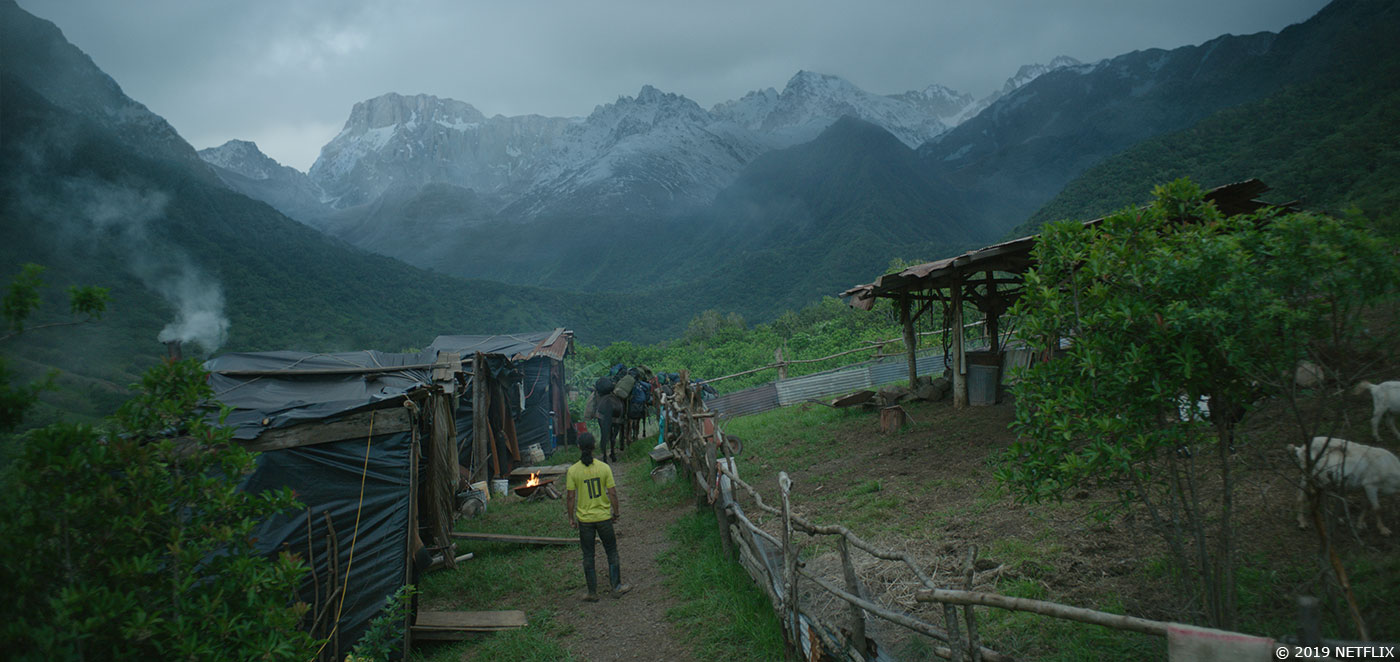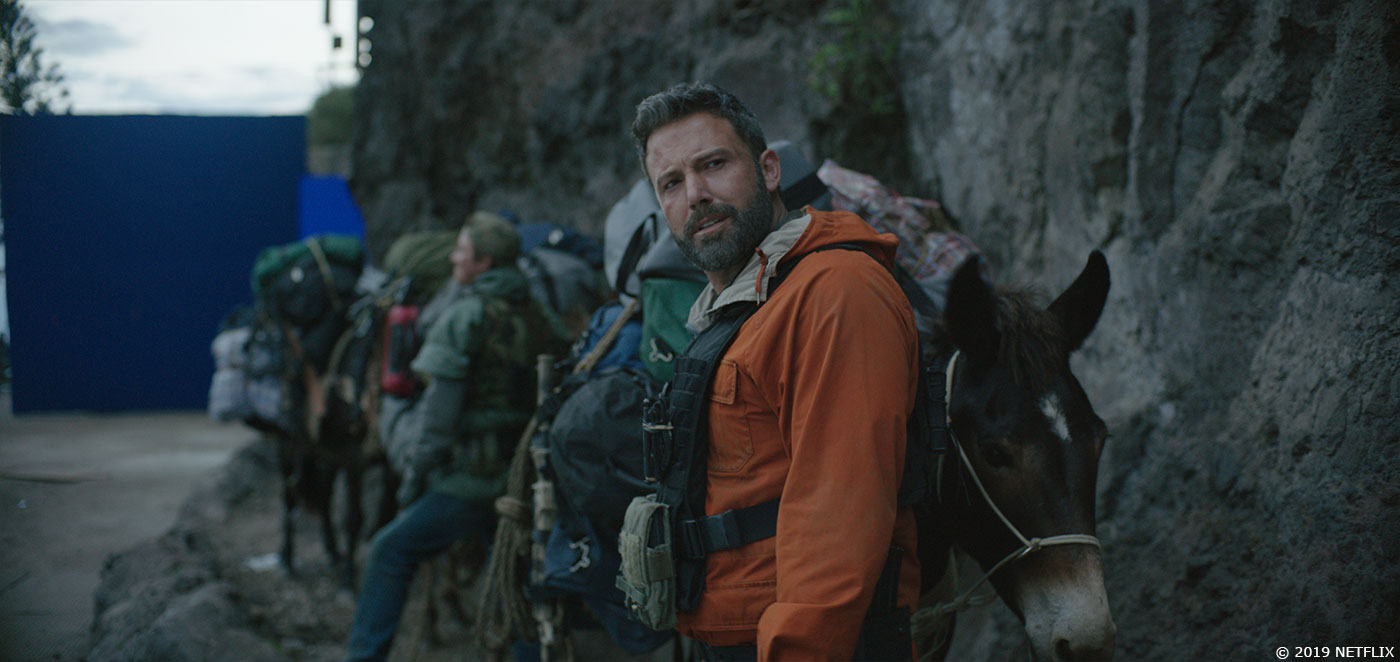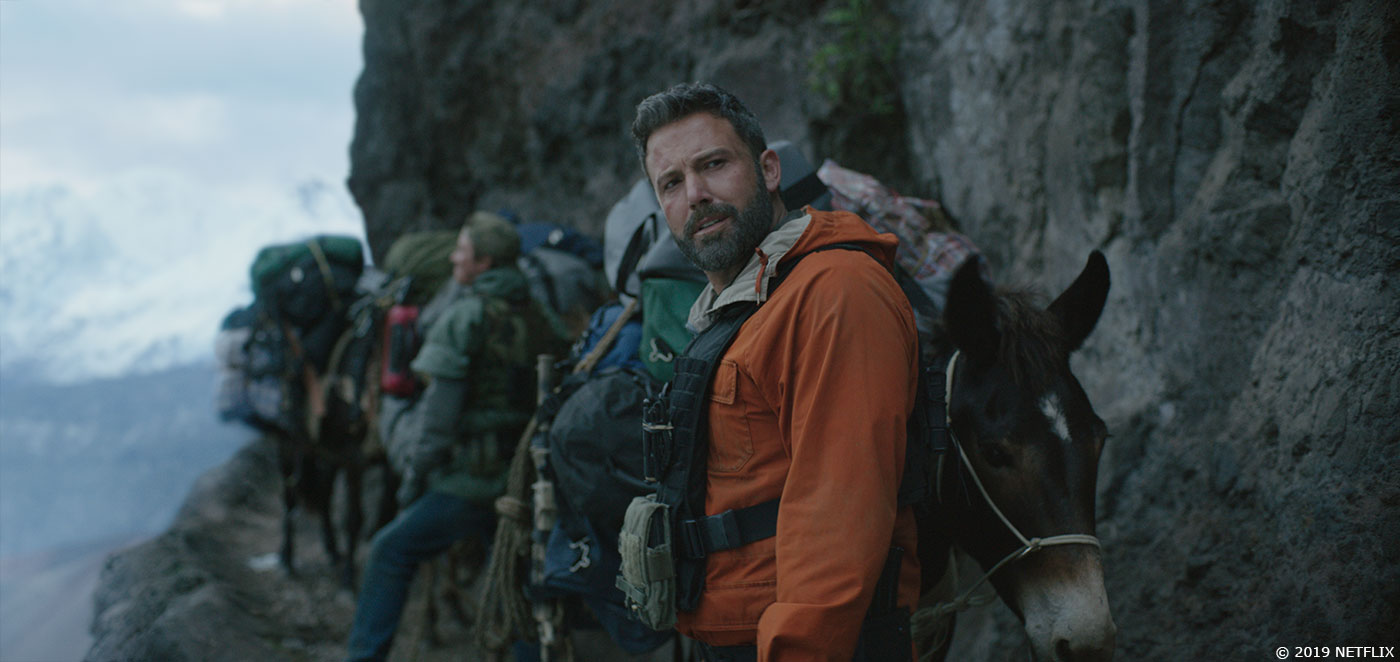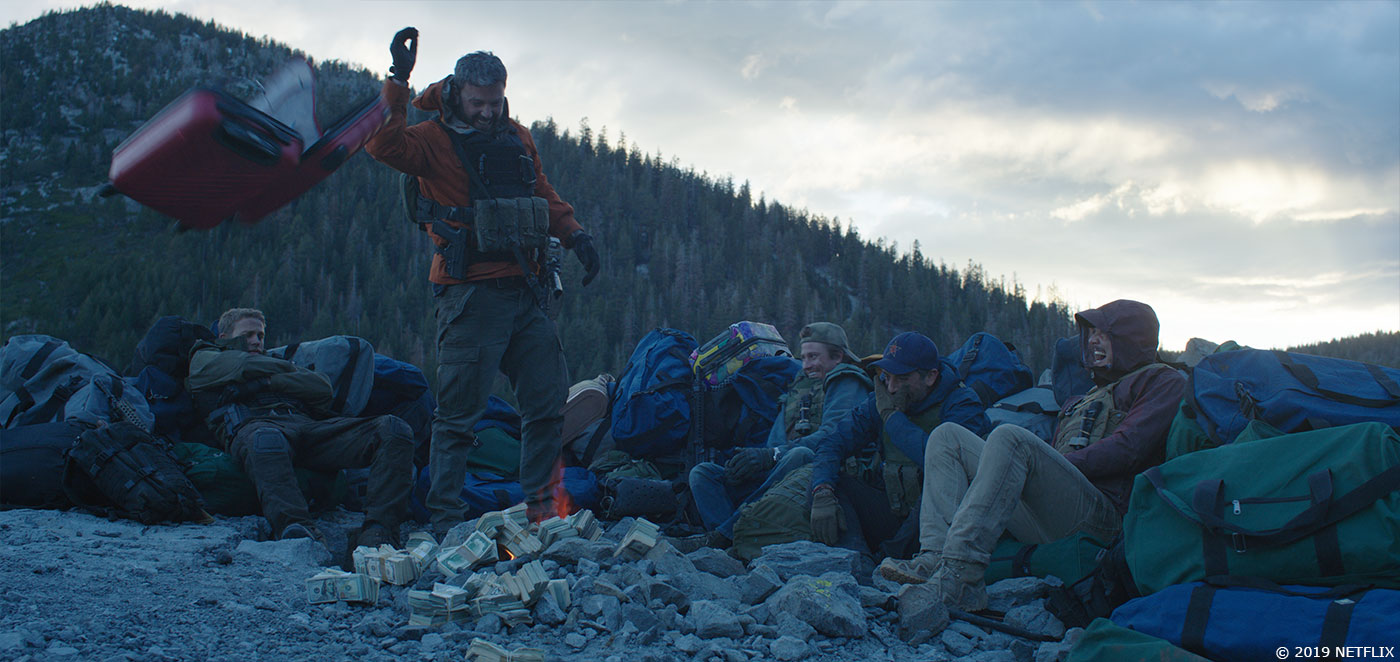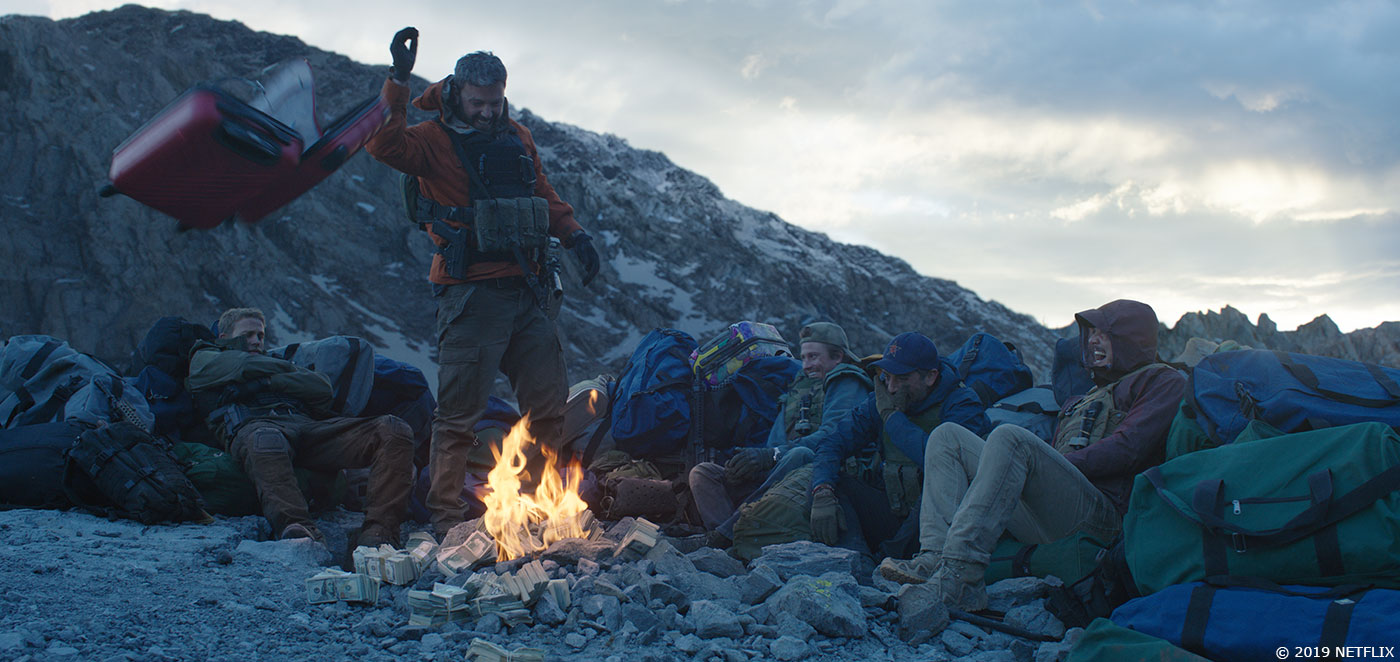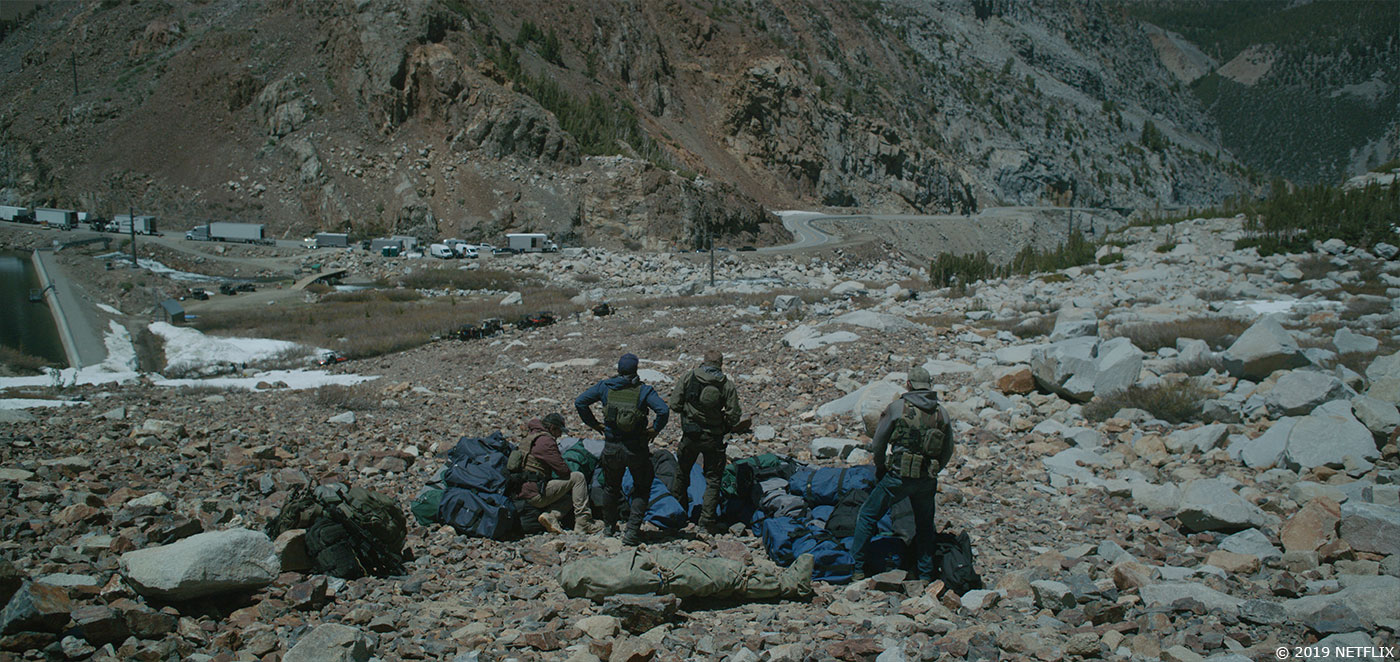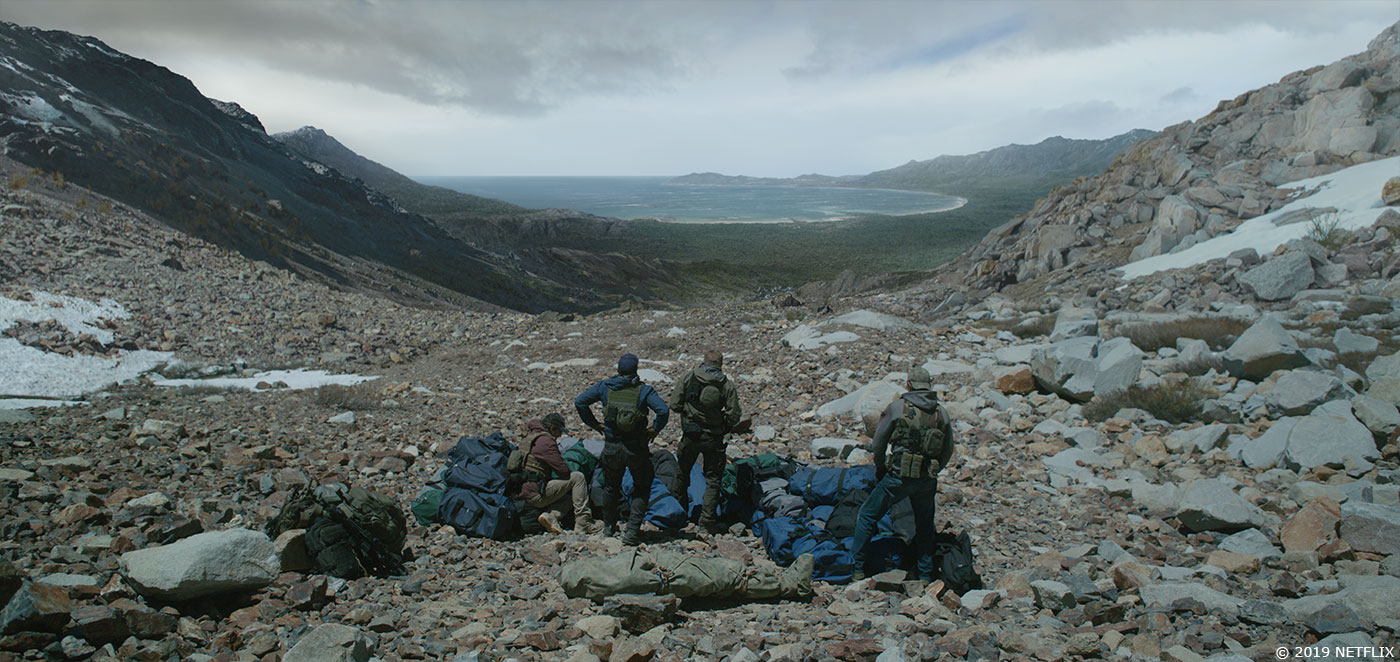Chris Keller started his career in visual effects in 2010 at DNEG. He has worked on films such as TOTAL RECALL, MAN OF STEEL, AVENGERS: AGE OF ULTRON and PACIFIC RIM: UPRISING. As a VFX Supervisor, he took care of the effects of films like ANT-MAN AND THE WASP and HOLMES & WATSON.
What is your background?
My VFX background is in compositing. Before that, I was a programmer working in computer graphics, games and the early days of VR. I have also been writing and directing short films for a while, and this filmmaking experience constantly feeds into my VFX work.
How did you and DNEG get involved in this show?
I had just returned from a stint in Vancouver when the show was pitched to me in March 2018. My face lit up when J.C.’s name was mentioned, and a few weeks later, I found myself on set in Hawaii.
How was the collaboration with director J.C. Chandor and VFX Supervisor Mark Russell?
I’ve been a fan of J.C.’s work since MARGIN CALL. In my opinion, each of his films is a masterclass in storytelling. He is one of the most exciting voices working in movies today. Working with him was a rewarding experience. He brings a great amount of contagious energy to the set and is a fantastic collaborator.
Mark Russell is on the same wavelength as J.C.. He is a very experienced and confident supervisor who is also a wonderful filmmaker and storyteller. It was very reassuring working with a team that cared about the story, and wanted to make the best film possible.
What were their expectations and approach on the visual effects?
Mark’s golden rule throughout the show was that the VFX had to be integral to the story. J.C. didn’t want spectacle for spectacle’s sake – every shot had to have a point of view and advance the story.
We strived to achieve as much as possible practically. From shooting the entire film on location using mostly natural light to hiring a Mil Mi-8 helicopter, we made sure there was always something real to work from, even if it was to be replaced in post.
How did you organize the work with your VFX Producer?
Jenn Fairweather led the show from DNEG Montreal. She is, in my estimation, one of the best in the business and she was the absolute bedrock for the team. I worked across three offices and travelled a lot, so having solid production backup was essential. Jenn understood where Mark and I wanted to take the show and worked her magic behind the scenes to make sure all our goals could be achieved. A good supervisor / producer relationship is crucial and I feel like producers often don’t get the credit they deserve. My entire production team was fantastic, allowing me to focus on the creative work.
How did you split the work amongst the DNEG offices?
The show was led from the Montreal office, with the bulk of the shot work being done in Mumbai. I had a small core team in London where I am currently based and I travelled between the three locations.
What are the sequences made by DNEG?
As the lead vendor, we were tasked with enhancing and transforming the ever-changing landscapes as we follow our characters on their journey through the Andes. In addition to developing key environments to help tell the story of their arduous climb through the jungle and mountains, our work included complex character animation of a CG mule, and animation and destruction of a Mi-8 Helicopter.
Can you tell us more about the previs and postvis process?
The helicopter journey and crash was heavily previs’d by Brigade. This was essential because it’s a long complex sequence that was put together using plates shot in various locations; foreground elements shot against white screen; a real Mi-8 helicopter; and plenty of CG to fill the gaps to add realism.
Most of our postvis effort was spent on the “mule drop” sequence. For obvious reasons we did not throw a real donkey down a cliff, and therefore editorial was missing an entire beat. We helped by blocking out the fall in animation and providing multiple camera angles that corresponded with the characters’ points of views. Not only did this help figure out the timing, it also informed J.C. and the studio about how cruel the sequence would look to audiences, which was a concern.
Can you elaborate in detail on the creation of the Mi-8 helicopter?
As I mentioned, production hired a real Mi-8 helicopter, and we tried to get as many shots in-camera with the aim to add CG smoke during the crash sequence. Now, the Mi-8 is a massively heavy machine and couldn’t fly dramatic stunts, so we ended up replacing it entirely using CG in quite a few shots. Having the helicopter on set allowed us to gather detailed photographic reference. We also took LIDAR scans and HDRIs at every location. All this data allowed us to recreate a digital photo real Mi-8. Lastly, we took the finished asset and created a damaged variant that we could transition into during the crash sequence.
How did the high altitude affect your animation work?
If you fly a helicopter or even just drive a car at 1,200ft, you can definitely feel it struggling due to the lack of oxygen. In addition, our Mi-8 is carrying tons of cash, so much in fact that it’s redlining. We added very subtle banking and vibration, but this transport helicopter is a whale of a machine, weighing around 10 tons, and you simply wouldn’t see much high-frequency movement in wide exterior shots. Every time we increased the amount of rumbling, the helicopter lost its sense of scale.
Can you explain in detail the crash in the coca fields?
The Mi-8 can’t take the weight of the money and one of its gearboxes blows, forcing the gang to turn around and crash-land in a valley. Unfortunately for them, cocaine farmers inhabit the valley – not the best location to crash with a bunch of stolen drug money!
All the helicopter interiors were shot using a buck. We used a white screen rather than green, which meant a little more roto work, but it provided more natural lighting. We shot background plates during multiple helicopter flights in the Sierra mountains and Hawaii’s Kualoa ranch. For this, we referenced the previs to make sure every beat was covered.
Almost every wide shot during the approach to the crash site was shot with the real Mi-8. We ended up replacing it in about half of those shots to increase the sense of danger with out-of-control maneuvers that the real helicopter couldn’t perform. All of the helicopter exteriors, real or CG, feature CG smoke streaming out of the exhausts.
The aircraft finally touches down and goes into a spin, which is very closely based on video reference of a real crash. Again, our goal was to keep everything as realistic as possible. There is a temptation to over-animate an action sequence like this. Interestingly, giving the CG helicopter the sluggish weight it would exhibit in reality gave the sequence more impact. It’s like watching the Titanic sink, as this huge machine slowly becomes unstable and begins to tip over we (the audience) anticipate the havoc about to be caused by the force of the rotor hitting the ground. This anticipation creates suspense. We had a practical helicopter body mounted on a spin rig on set, which, peppered with mortars and smoke SFX, created an impressive scene. Even though we replaced most of it with CG, the spinning vehicle gave us an excellent reference and actor Garrett Hedlund something to react to. While the helicopter is the star of this sequence, we also did a great amount of set extension work, adding coca fields and connecting the valley with the distant Andes Mountains.
Can you tell us more about the FX work on the crash?
Smoke was the biggest FX task across the crash sequence. Getting the physics and complexity of CG smoke right is not an easy task, and we were dealing with the added difficulty of rotor forces from the helicopter. We compiled a library of video reference from air shows and helicopter crashes that we referred back to. Once the helicopter is close to the ground, we added dust, debris, leaves, and coca plants bending in the wind. Over the course of the crash, we are gradually transitioning to a damaged model of the helicopter that matches the set-dressed prop in the following sequence.
How did you create the digital doubles?
We shot photogrammetry passes of the cast. Through clever editing and compositing we were able to keep the digi double work to a minimum.
The movie takes us to various locations. How did you create these environments and especially the Andes?
The movie was shot in breath-taking locations that were a great basis for our environment work. Our main task was to turn Hawaii and California into South America. Not only that, we also had to make sure that the journey was coherent by connecting the various set pieces. We created a 3D reference map of the fictitious terrain the characters travel through and we plotted both the helicopter flight and the trek. That way, we could always tell how high up we were i.e. the ratio was between jungle, rock and snow; which way was the camera looking and which landmarks should we see (one landmark was the distinctive peak they attempt to fly and later hike over). We sent a unit to Argentina to capture footage of various Andes landscapes. The footage we shot during our helicopter plate flight also came in handy.
Which one was the most complicated to create and why?
Our biggest environment was the coca valley, for which we laid out miles of CG coca fields, jungle and distant mountains. The most complicated, however, was the mule cliff drop, which had to be laid out in a specific way that conveyed a sense of vertigo and allowed the CG mule to bounce just the way J.C. and Mark had envisioned. Then it had to be executed to a high standard that held up against the foreground set.
How did you create and animate the mule?
As with the helicopter, we took a huge amount of photographic reference of our mule. We were planning to do a CG handover from the real mule – which performed a small jump on set – to the animal slipping and falling down the cliff. Therefore we aimed for a 100% match, and spent much time finessing every aspect of the asset.
For the animation, we gathered rather morbid video reference of animals tumbling down cliffs. We went back and forth on how much emotion the mule should show, and how it would convey fear. Based on our reference materials, we mostly focussed on the eyes and ears, and we made the animal kick and buckle. Another interesting challenge was that the cargo shifted the center of mass, which affected the tumbling animation.
Which sequence or shot was the most challenging?
Technically, the mule drop and helicopter crash were the most challenging. Creatively, it was the number of wide shots in the mountains that lay out the journey.. Specifically, there are two shots where the guys have almost made it down the side of the mountains, and they can see the ocean in the distance. We had to create two thirds of the image from scratch, creating a particular environment we couldn’t find anywhere on earth: transitioning from a rocky slope to jungle, leading to a small fishing village and a bay with a beachhead that would become the location for the final chase. Combining so many disparate elements into a photo real matte painting was a huge artistic challenge.
How did you handle the challenge of delivering your shots in 4K?
4K shows are increasingly common, and our pipeline is well equipped to handle it with proxies etc. The more interesting challenge on TRIPLE FRONTIER was that it was an HDR show, which is relatively new at this point. Essentially, this required all of our work had to be delivered to the highest quality, so, the tech check process became a little more involved.
Is there anything specific that gave you some really short nights?
Well, by definition, there are the night shifts on set… We had the usual crunches and some last-minute changes, but overall it was pretty smooth sailing. I will say that a global show like ours definitely extends the working day for the supervisor, because someone is always in the office somewhere.
What is your favorite shot or sequence?
There is a wide shot in which the Mi-8 first crosses into the coca valley, collides with a tree and drops a few feet as the engine cuts out. I love this awesome reveal of the valley, and am very pleased with the photorealism achieved by the team.
What is your best memory on this show?
There are so many! Shooting the film with a bunch of great people in gorgeous locations, flying stunts in Kualoa Ranch (and making it 90 minutes into the flight before finally throwing up during landing), directing mules swimming in an Olympic size pool (Did you know they’re rather stubborn?); and hanging out with my amazing teams in Montreal and in Mumbai.
How long did you work on this show?
10 months – The shoot began in March 2018, and we delivered our last shot in late January 2019.
What’s the VFX shots count?
About 400 of our shots made it into the movie.
What was the size of your team?
Around 500 people worked on TRIPLE FRONTIER.
What is your next project?
Ask me again next week and I may be able to talk about that.
What are the four movies that gave you the passion for cinema?
I don’t keep lists, so allow me to go for a cop out and give you my list of four directors I admire for the way they approach narratives: Hitchcock, Fincher, Cuaron, Spielberg. Oh, and of course, Mr J.C. Chandor.
A big thanks for your time.
TRIPLE FRONTIER – TRAILER
WANT TO KNOW MORE?
DNEG: Dedicated page about TRIPLE FRONTIER on DNEG website.
Mark Russell: My interview of Overall VFX Supervisor Mark Russell.
Netflix: TRIPLE FRONTIER is streaming now on Netflix.
© Vincent Frei – The Art of VFX – 2019


